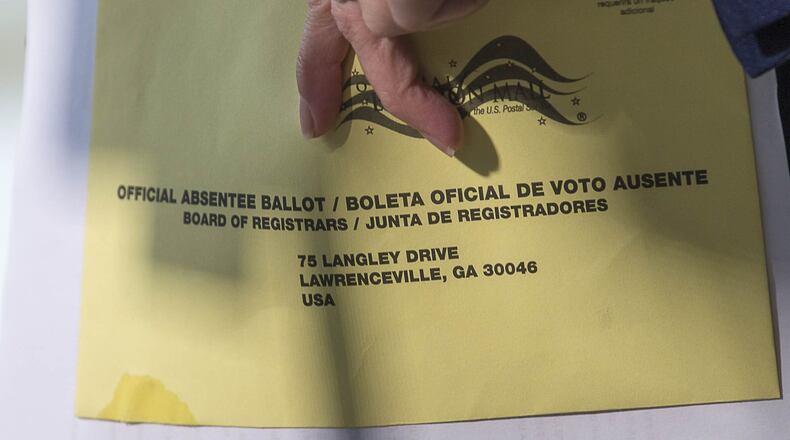When Bartow County resident Shelly Hamner filled out her absentee ballot for the November general election, she had her husband check her work.
“I’ve never really done absentee before,” she said. “I said, ‘Make sure I did this right. I don’t want it to be rejected.’”
Georgia’s absentee ballot looks much like any other ballot, but it has to be mailed back in a special envelope that requires the voter to correctly list their address, birth year and sign an oath saying they were entitled to cast their vote.
After the spousal double-check, Hamner mailed the ballot to her county office only to have it rejected because the county elections office decided her signature wasn’t a match with the one on file. Fortunately, word came early enough that the county offered her the option of casting her ballot in early voting, but that process took hours and a lot of explaining.
“I had to tell the story to four different people. They had to make a phone call, and they pulled me out of line,” she said. “I was like, ‘Is this happening to me?’ You see this on the news.”
The Atlanta Journal-Constitution analyzed 245,000 absentee ballots cast in every Georgia county in the Nov. 6 general election and found a chaotic system where ballots were accepted — or not — based on local interpretations of state rules. And the actual number of absentee ballots discarded for any of these rules is unknown because many Georgia counties elected not to report them to the Secretary of State.
The analysis found that county election officials reported rejecting nearly 7,000 ballots, or 3 percent of the total votes cast, often for relatively minor transgressions such as marking the outside of the absentee ballot envelope incorrectly.
Barry Burden, director of the Elections Research Center at the University of Wisconsin, said Georgia's 3 percent rejection rate is significantly higher than the national rate. More troubling is the variation by county, he said. Some counties reported rejecting 10 percent of their absentee ballots, while others reported almost no rejections.
"The variation … indicates that different standards are being applied across the state," he said.
Minority voters were twice as likely to have their ballots rejected, according to the AJC’s analysis. The Democratic Party of Georgia has made a similar claim in its own analysis.
“The evidence shows a substantial difference in the rejection rates for absentee ballots submitted by whites versus various minority groups,” Burden said. “This is a bothersome disparity that has been seen in other states as well.”
State law requires county election officials to inform voters as soon as possible when a ballot is rejected. But records indicate only one in nine voters whose absentee ballots were rejected ultimately got their vote counted, either because they corrected the error with their ballot or voted in person.
Incomplete data
The full number of rejected absentee ballots is unknown.
Thirty-five of 159 counties — including populous counties like Fulton and Hall — reported to the Secretary of State they rejected no ballots in this year’s general election. Those same counties rejected 2,019 in the last gubernatorial election in 2014.
An AJC analysis suggests those counties that haven’t reported any rejected ballots should have reported nearly 4,000 rejections, given the higher turnout this year. That figure would increase reported rejected ballots for the entire state this November by more than 50 percent to just under 11,000.
The AJC called some of those counties reporting zero and found some are sitting on their rejections. The election supervisor in Hall County this week said ballots rejected because they arrived after the election haven’t been reported. In Fulton County, officials said at least 275 ballots were rejected because the voter failed to sign the envelope on the outside of the ballot. Those also are not reflected in the statewide figures.
In addition, Fulton County rejected 230 absentee ballots that arrived after the election, officials said. The county has no plans to report those rejections to the Secretary of State.
Thousands rejected over birthdays, signatures
From the available data, it is clear some ballots were rejected for reasons beyond the control of county officials. For instance, nearly 1,000 ballots were returned after election day, too late to be counted according to Georgia law. And more than 150 others were rejected because the post office returned them as undeliverable.
Other problems were more picayune and largely involved mistakes made in filling out the form on the back of the envelope containing the finished ballot. And the standards for what merited rejection varied from county to county.
Carroll County Elections Supervisor Greg Rigby said when his staff found a problem with an absentee ballot, they pulled it out and called the voters to come in and fix it, instead of rejecting the ballot outright.
“If you filled it out and we know who you are … we are going to call you,” he said. “Maybe that’s not feasible for some larger counties.”
In mid-October, Gwinnett County's rejection rate, particularly on the issue of alleged signature mismatches, drew the attention of civil rights groups. At the time, the county's rejected ballots accounted for more than a third of rejected ballots statewide.
U.S. District Court Judge Leigh May issued an injunction on Oct. 25 requiring signature mismatch ballots to be counted. According to data reviewed by the AJC, even after counting signature mismatch ballots Gwinnett rejected 1,632 absentee ballots in the general election, more than any other county and twice as many as DeKalb, which was second on the list.
Stephen Day, chairman of the Gwinnett County Board of Elections, said he was unaware the county’s rejection rate was a problem until this election. County employees were attempting to follow the law, without a lot of outside guidance from the state, he said.
Day said procedures vary from county to county and reporting rejected ballots is “all over the place.”
"Our hope and plea is that the Legislature and the new secretary of state gets this straightened out so we are all on the same page," he said.
One student’s experience
Last year, state lawmakers tinkered with the absentee process. House Bill 268 changed the oath on the outside envelope to require voters to list their birth year, rather than the month and day of their birth. Some counties mailed out old-form envelopes, others mailed out the new form. Some, like Cobb County, did both, mailing out the old envelopes until they were exhausted and then sending out new ones.
Democrats have seized on problems with Georgia’s absentee voting as one item in a list of post-election grievances after several top candidates, including gubernatorial hopeful Stacey Abrams, lost by close margins.
Almost immediately after the general election, Fair Fight Action, a newly formed non-profit backed by Democratic gubernatorial candidate Stacey Abrams, filed suit in federal court alleging a litany of problems, including absenting voting.
Democrats worked hard to get college students, a low-turnout group, to vote by absentee ballot. Allegra Lawrence-Hardy, lead attorney in the Fair Fight lawsuit, said problems with those ballots are “absolutely a trend.”
First-time voter Hannah Krawczyk, a 19-year-old sophomore at Auburn University, had her absentee ballot rejected by DeKalb County over a perceived signature mismatch. At first, it wasn’t clear why her vote wasn’t counted, she said.
"All that happened is they sent me a letter saying it was rejected," she said. "I called to ask what was going on."
Krawczyk said she called the DeKalb County Board of Elections to find out the problem and the election official reinstated her ballot and had it counted.
“They basically dug it out of the pile and put it back into the system,” she said.
Lawrence-Hardy said those kinds of procedural problems are dispiriting.
“When you have a college student who is willing to go through the trouble of getting the ballot, monitoring it, checking to make sure it got counted, and then calling us to say it didn’t get counted, that concerns me,” she said. “They worked so hard, and you know you’ve got 19-year-olds who don’t go to the polls at all.”
284,422: Ballots requested
282,798: Ballots mailed to voters
244,628: Ballots returned
4,148: Ballots rejected for errors*
2,535: Ballots rejected for lateness*
*More than three dozen counties have yet to fully report data on rejected and late-returned ballots.
Source: Georgia Secretary of State
Why it matters
Record turnout in the November election tested Georgia’s voting mechanisms, from aging electronic voting systems to vote-by-mail absentee ballots, and left thousands of voters wondering if their votes were counted. Today’s story examines how and why Georgia counties rejected thousands of absentee ballots cast in the election.
Keep Reading
The Latest
Featured








